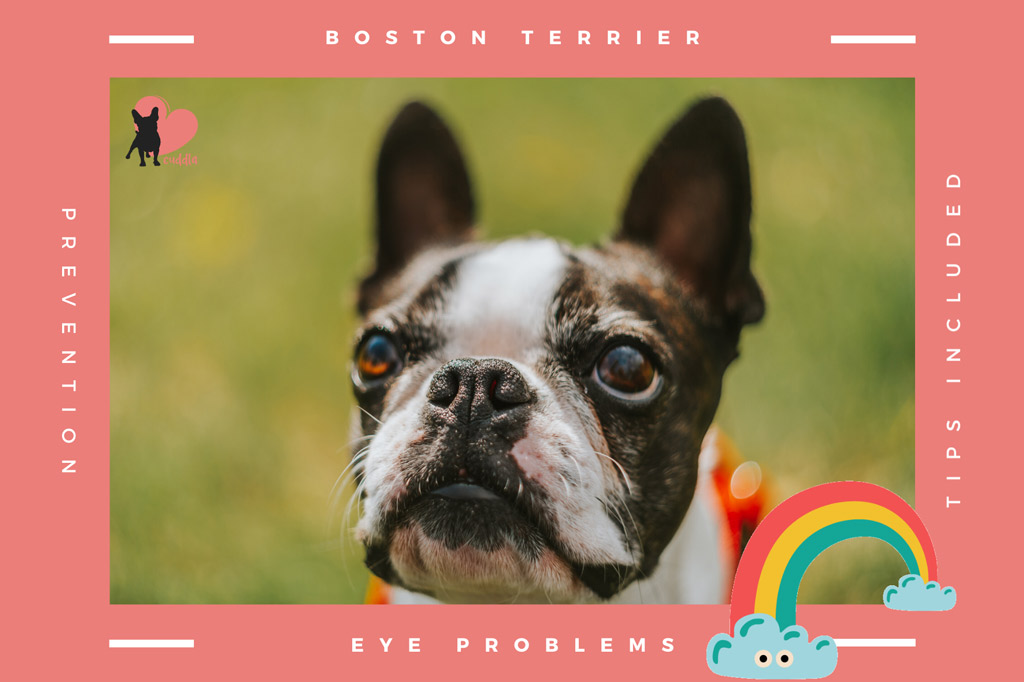
Do Boston Terriers have eye problems?
Unfortunately, Yes. Boston Terrier’s bulging eyes place them at risk for certain health problems.
In this guide, you will find out which are the most common Boston Terrier eye problems, which of those are hereditary, and what you can do to prevent and treat them.
Boston Terrier Eyes
According to the AKC Breed Standards, Boston Terriers’ eyes are dark in colour (brown), large and round.
They are situated wide apart, set square in the skull, and the outside corners are in line with the cheeks when looking from the front.
And there are 2 reasons that would disqualify a Boston Terrier from the breed standard:
- Eyes showing too much white or haw.
- Eyes blue in colour or any trace of blue.
So if you are wondering… Do Boston Terriers have blue eyes? The answer is they shouldn’t. It’s not part of the breed standards, which ensures the breed’s aesthetic appearance and also their health.
Dogs bred for specific appearance traits like “Boston Terriers with blue eyes” or “Boston Terriers with blue/grey coat” are doing so with no regard for the dog’s health!
They are doing it to satisfy a fashion, popular demand or some people’s preferences, ignoring the Boston Terrier’s health.
With that said, let’s move on to the main topic: their eye problems.
Read also: What Is a Blue Boston Terrier? A Guide to Breed Standards.
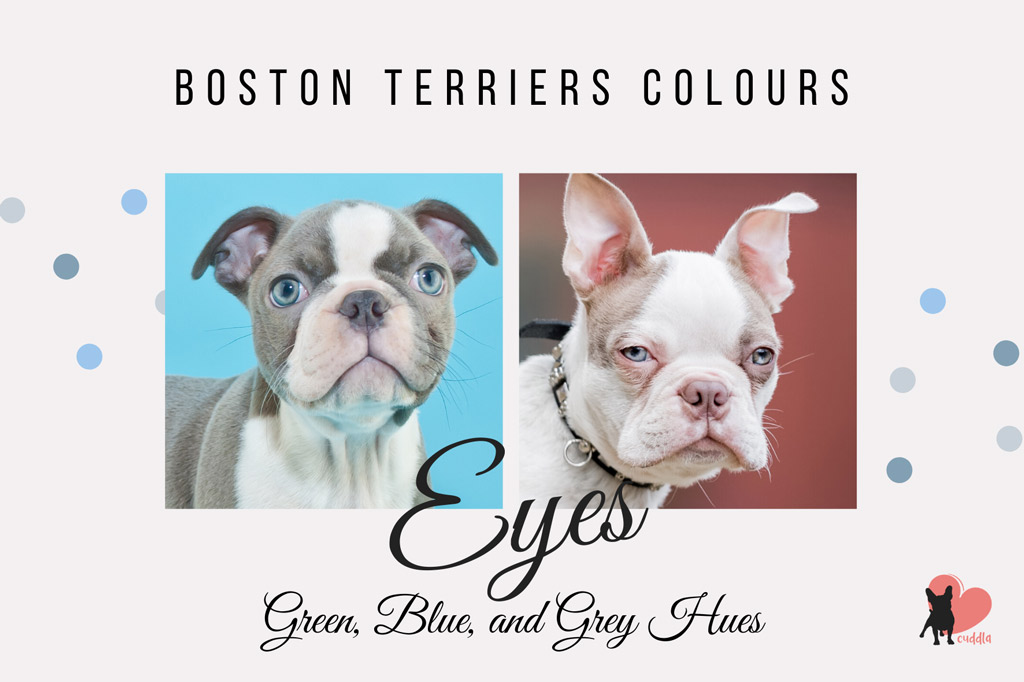
Boston Terrier Eye Problems
Most of the health problems associated with this breed are due to their “funny” face, including their prominent eyes!
Boston Terriers suffer from hereditary eye diseases such as glaucoma and cataracts. The main contributors to this have been irresponsible breeding, which causes these diseases to be transferred to pups.
These are the most common Boston Terrier eye problems:
- Cataracts.
- Corneal Ulcers.
- Glaucoma.
- Cherry Eye.
- Keratitis Sicca (Dry Eye).
- Corneal Dystrophy.
- Strabismus.
- Distichiasis.
- Entropion.
- Other.
#1 – Cataracts
Cataracts is a condition where the eye’s natural lens gets cloudy, causing a decrease in vision clarity, and will eventually lead to blindness. But, cataracts may remain the same in size and shape over time too.
Boston Terriers have at least two distinct forms of inherited cataract:
- Juvenile cataracts: This is a hereditary condition that starts to appear by 15 months of age. In this case, the HSF4 gene is responsible (source). This form of genetic cataract is always bilateral (affecting both eyes) and progresses rapidly. If a puppy is found to have cataracts, it means BOTH parents are carriers for the condition.
- Late-onset cataracts: They occur over time as the dog ages; they usually start to develop at 3 to 6 years of age. The genetic mutations for this form haven’t been identified yet.
According to the 2000 Health Survey, about 2.4 % of Boston Terriers are showing up with these Juvenile Cataracts and about 9 % of Boston Terriers have these Late-Onset Cataracts.
However, cataracts may also develop due to (source):
- Trauma to the eye.
- Metabolic diseases such as diabetes.
- Nutritional disorders during puppyhood.
- Or secondary to other eye diseases.
Signs:
- Bluish, grey or white colour change inside the eye.
- A tendency to bump into things.
- Reluctance to climb the stairs or jump onto the couch.
- Hesitancy in unfamiliar environments.
- Inflammation or redness of the eye.
- Pain and squinting.
Treatment: There is no medical treatment available to reverse cataracts, to prevent cataracts or to shrink cataracts. Whether a dog is a candidate for cataract surgery can be determined by a veterinary ophthalmologist.
Prevention: Usually, cataracts are an inherited trait. So, unfortunately, there’s not much you can do to avoid it if your dog has inherited the HSF4 gene.
However, if you are looking to get a Boston and are concerned, commercial genetic tests are available (CERF examination). Find out more at the #6 – Getting Your Boston From a Reputable Breeder or Rescue Group section below.
#2 – Corneal Ulcers
Corneal Ulcers are the single largest eye problem in Boston Terriers. The 2000 Boston Terrier Health Survey claims that nearly 1 in 10 dogs will experience a corneal ulcer.
Due to how prominent Boston Terrier’s eyes are, corneal ulcers are particularly common.
It’s a painful eye condition that is initially caused by trauma to the cornea of the dog’s eye. That can look like:
- A scratch or an injury to the eye.
- Eye irritation.
- From particles in the environment like dust and sand.
- From eyelashes or facial hairs.
- An infection.
- A lack of moisture in the eye.
Insider Tip: Removing Boston Terriers’ whiskers may be a reason that eyes become injured due to lack of sensory feelers.
Signs:
- Repeated eye rubbing.
- Keeping one of the eyes closed at all times.
Treatment: Corneal ulcers can be difficult and expensive to treat and can result in the loss of the eye. In mild cases, the ulcers can heal following your vet’s specific treatment.
Prevention: The best way to prevent it is to protect your Boston Terriers’ eyes. Check the #5 – Keeping Boston Terriers’ Eyes Safe from Hazards section below for some helpful tips!
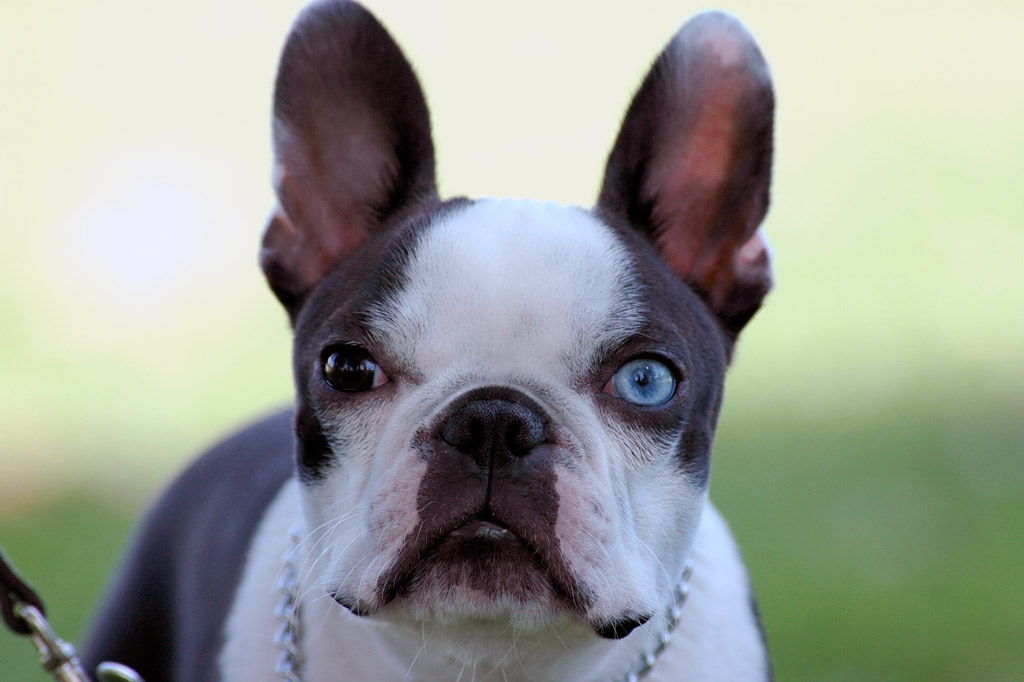
#3 – Glaucoma
Glaucoma is another hereditary eye condition that typically shows when dogs are around 2 years old. The 2000 Health Survey said that it affects about 1% of Boston Terriers.
It results from fluid buildup in the eye.
As pressure inside the eye increases, it can cause the dog a great deal of pain and it can also affect the dog’s vision. As a result, glaucoma can rapidly lead to total blindness if left untreated.
Signs:
- Squinting.
- Watery eyes.
- Bluing of the cornea (the clear front part of the eye), and redness in the whites of the eyes.
- Pain, although this is not so easily noticeable as a pet owner, even though it is frequently there and can be severe.
In advanced cases, the eye may look enlarged or swollen like it’s bulging.
Treatment: Glaucoma is a medical emergency. If you see symptoms, call your vet or go to an emergency clinic.
Prevention: Annual check-ups, including eye tests (screenings), are key to spot and diagnose a disease in its early stages, and then start treatment as early as possible. Check the #2 – Going for Vet Check-Ups section below.
#4 – Cherry Eye
Cherry eye occurs in about 6% of Boston Terriers according to the 2001 Health Survey.
This is a painful condition that affects a Boston Terrier’s third eyelid. It happens when the gland (located on that third eyelid) pops or bulges out of its original position. As a result, it swells up outside the eye, causing the unsightly cherry eye.
Cherry Eye is a congenital defect that has a breed predisposition, but the mode of inheritance is unknown.
Signs:
- Similar to a tumour in the eye.
- A bright red mass protruding out of the eye.
Treatment: Cherry Eye may need to be corrected surgically to reposition the third eyelid and the tear gland.
Prevention: Again, regular eye check-ups.
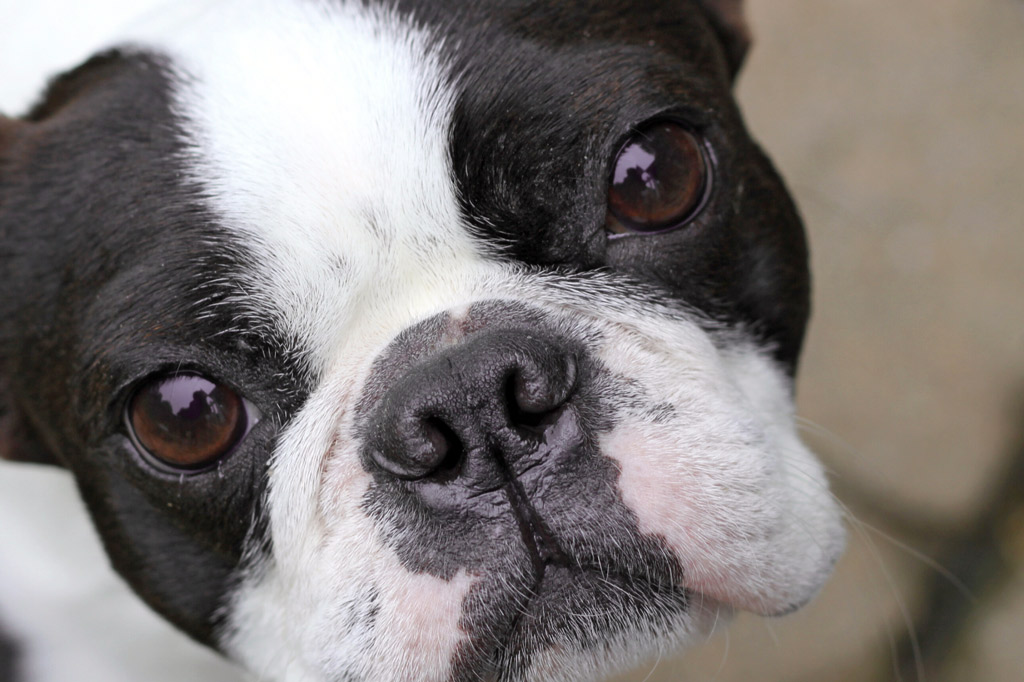
#5 – Keratitis Sicca (Dry Eye)
Keratitis Sicca, also known as Dry Eye, happens when an ulcer damages the cornea of your dog’s eye. The cause is an inadequate tear production.
Tears are necessary for lubrication and overall eye health. When your Boston is not producing enough tears, the surface of the eyes becomes irritated and sore.
This can cause ulcers to form and can result in painful and chronic eye infections.
In severe cases, it can lead to perforation of the eye itself. In chronic cases of dry eye, the surface can scar, creating a cloudy, dull appearance.
This condition occurs in 1 in 50 Boston Terriers very early in life. Also, it’s believed to be inherited but the mode of inheritance is unknown.
Dry eye is often associated with an autoimmune inflammation of the tear glands and can be a chronic, lifelong condition.
Signs:
- Cloudy eyes.
- Dull and dry eye appearance.
- Mucous discharge from the eyes.
- Redness around the whites of the eye.
- Swelling of the tissue on the surface of the eye and eyelids.
- Squinting or excessive blinking.
Treatment: Dry Eye can usually be treated with tear-stimulating medications and topical antibiotics. In severe cases, there are surgical options available (source).
Prevention: Regular eye check-ups. Diagnosis includes an eye exam and sometimes a test to measure the amount of tear production and moisture in the eye.
#6 – Corneal Dystrophy
There are two different types of corneal ulcers:
- Corneal Ulcers: These are caused by trauma to the cornea of the dog’s eye. The most common one, which I mentioned above (#2 – Corneal Ulcers).
- Corneal Dystrophy: This one is caused by a hereditary condition.
- Corneal Dystrophy-Epithelial/Stromal: A non-inflammatory corneal clouding (white to grey) present in one or more of the corneal layers; usually inherited and bilateral (affects both eyes).
- Corneal Dystrophy-Endothelial: An abnormal loss of the inner lining of the cornea that causes progressive fluid retention (edema). Typically, it becomes bilateral affecting both eyes. In the case of the endothelial disease, its mode of inheritance is unknown. – This is the version of Corneal Dystrophy that Boston Terriers have.
This disease begins as a fluid build-up which causes the cornea to appear white, causing edema. It affects the deepest corneal layer.
It begins at the edge of the cornea, progresses centrally and often involves the entire cornea. With time the edema results in keratitis and decreased vision.
This type of dystrophy can lead to a painful corneal ulcer which is difficult to treat.
According to Dr Julie Gionffrido, Boston Terriers have a form of Endothelial Dystrophy which usually begins in middle life (5 to 7 years old).
Signs:
- White looking cornea.
- A cornea with an opaque or cloudy appearance.
Treatment: It’s particularly hard to treat.
Prevention: Regular eye check-ups.
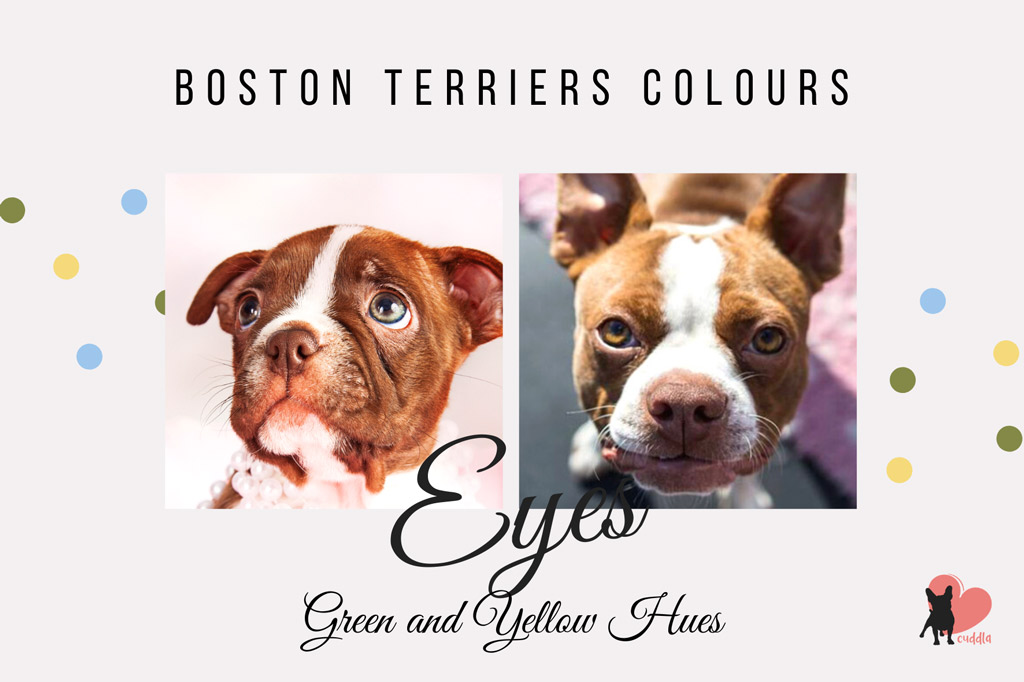
#7 – Strabismus
Strabismus is an eye condition in which the eyes point in the wrong direction. Rather than having both eyes pointing forward, parallel to the nose, the eyes turn inward toward the nose or outward away from the nose.
There are two types of strabismus, depending on the direction the eyes turn:
- Divergent Strabismus: When both eyes turn outward.
- Convergent Strabismus: When they turn inward. Bostons with this type of condition are often referred to as cross-eyed or walleyed.
It is possible to develop strabismus in only one eye, though it is commonly seen in both. In the case of Boston Terriers, strabismus is generally an inherited condition.
Although strabismus alters the direction of eyeballs, it doesn’t affect where they are located. I.e., the position of the eye within the socket remains normal.
In most cases, it doesn’t affect anything other than physical appearance and the eyesight remains intact.
Signs:
- Eye positioning issues. One or both of your pup’s eyes don’t look straight.
- Loss of appetite.
- Exhaustion.
- Problems walking.
- Chronic head-tilt.
- Conspicuous pupil size variances.
Treatment: Veterinarians often try to uncover the cause before proceeding to treatment.
Prevention: Genetic testing before getting a Boston Terrier.
#8 – Distichiasis
An eye condition where too many eyelashes grow around a Boston Terrier’s inner surface of the eyelid.
It can cause discomfort and may cause corneal ulcers to develop. Corneal ulcers may not heal because of the irritation.
Also, Distichiasis may occur at any time in the life of a dog.
There’s no evidence to prove that is a hereditary condition but it seems probable due to the high incidence in some breeds like Boston Terriers.
Signs:
- Eye irritation.
- Too many eyelashes.
Treatment: Removal of the hairs (by the vet) is usually the solution.
Prevention: Regular eye check-ups.
#9 – Entropion
Another eye condition where the eyelashes grow inwards, causing the hair to rub against the eyeball.
It can cause a reddened, inflamed eye, severe infections and deep ulcerated cornea.
Survey shows less than 1% of Boston Terriers are affected. It’s also believed to be an inherited condition.
Signs:
- Redness in the eye.
- Inflamed eye.
Treatment: Eyelid surgery.
Prevention: Regular eye check-ups.
#10 – Other Eye Problems
Also, they can have the following eye problems:
- Conjunctivitis.
- Epiphora (watery eyes), which causes tear stains.
- Keratoconjunctivitis sicca.
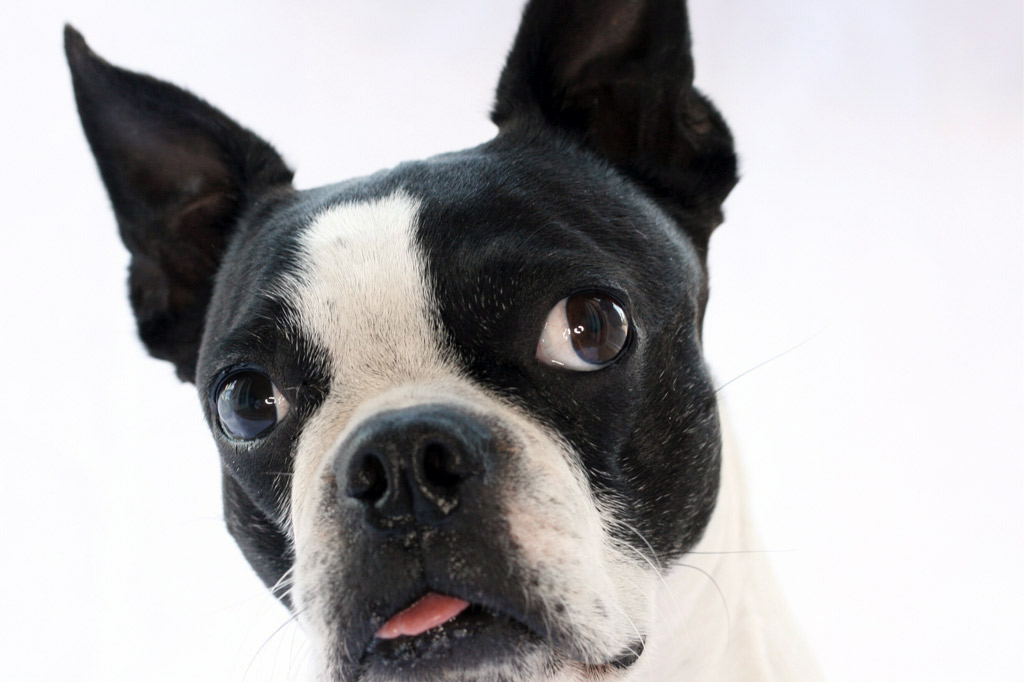
Boston Terrier Eye Problems Signs
You might not be able to know which eye condition your Boston has, but that’s what veterinarians are for.
As a dog owner, the best thing you can do is to monitor your Boston’s eyes for any changes. Here are some signs that your pooch has an eye problem:
- Excessively watery eyes.
- Excessively dry eyes.
- A noticeable increase in eye discharge.
- Change in eye discharge consistency or colour.
- Rubbing or pawing at the eyes.
- Excessive blinking.
- Bloodshot eyes (redness).
- Different sized eyes.
- A visible foreign object in the eye.
If any of these occur, don’t hesitate to take your pooch to vet for an appropriate diagnosis.
Insider Tip: If your Boston Terrier exhibits any sign of discomfort or eye irritation, consult your veterinarian immediately. Since their eyes are so delicate, better be safe than sorry!
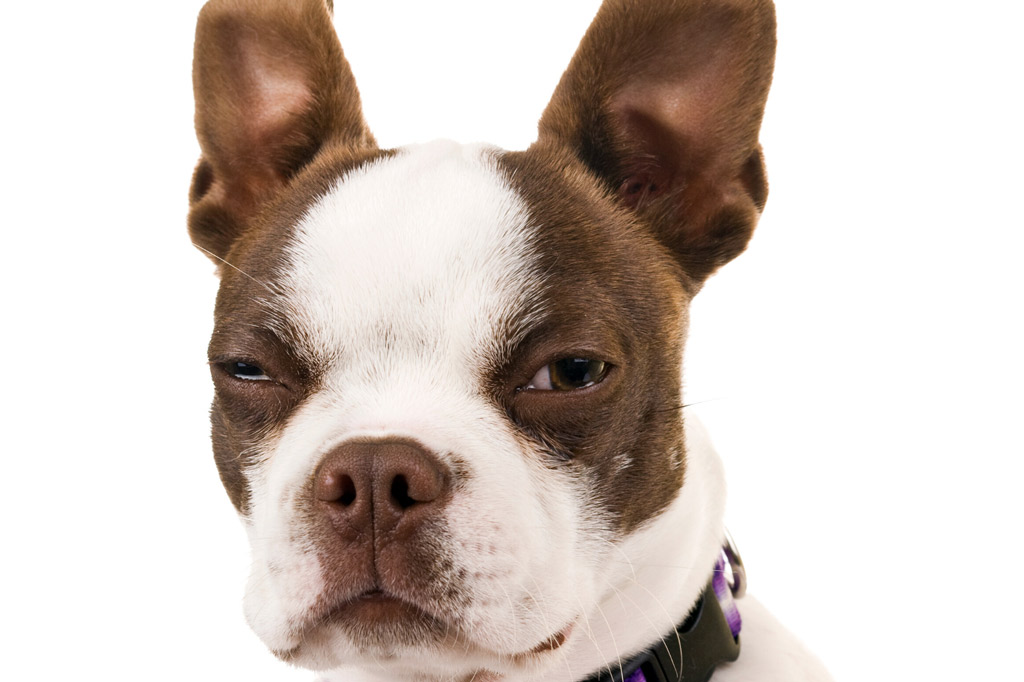
Boston Terrier Eye Problems Prevention
Now it’s time to address eye problems before they occur.
How can I stop my Boston Terrier from having eye problems?
#1 – Having Dog Insurance
Part of the prevention plan is to have good dog insurance.
Bostons are prone to have eye problems and other health issues that are breed-related, which add to the vet bill.
Thankfully, Petplan Pet Insurance covers all hereditary and chronic conditions as standard. Which means if your Boston Terrier inherits her dad’s bad eyes or her mom’s patchy coat, you’re covered.
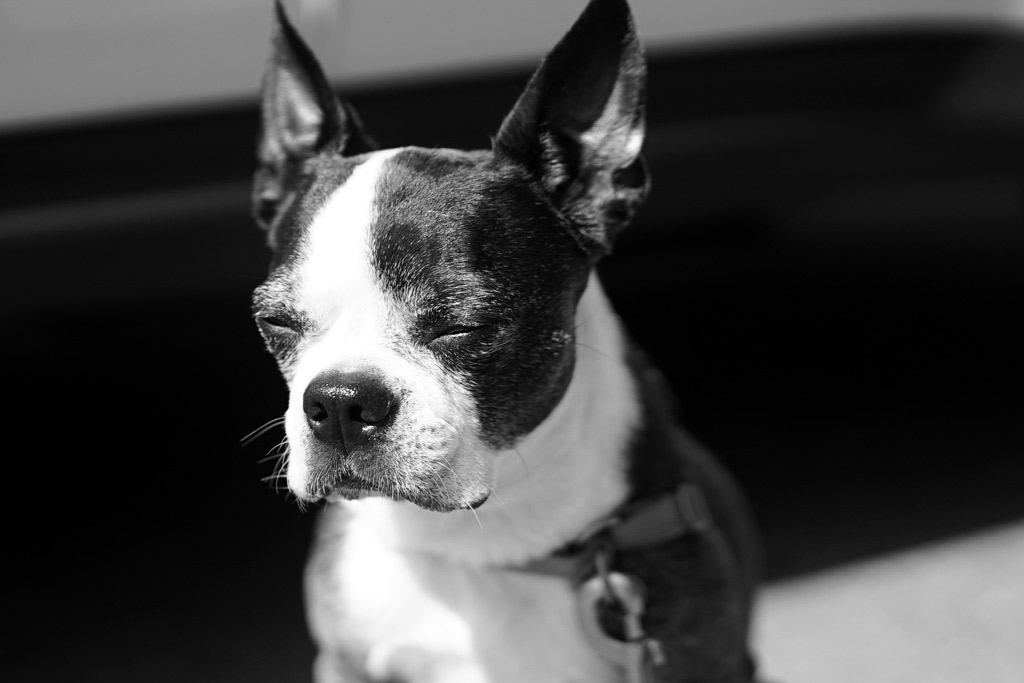
#2 – Going for Vet Check-Ups
This step is especially useful to spot a problem or signs in advance.
I recommend visiting your vet twice a year, with the change of season (spring and autumn), for a check-up.
For eye-checks, it’s necessary to visit a veterinary ophthalmologist to have a more thorough examination. A specialist will examine your dog’s eyes using an indirect ophthalmoscope and a slit lamp biomicroscope.
How often you take your pooch to the ophthalmologist will depend on your Boston Terrier’s health history: recorded hereditary conditions, a current eye problem…, etc.
Ideally, you have your Boston Terrier’s health records, which include genetic test and health certificates.
Without a genetic test, which detects hereditary eye conditions, your best defence is:
- An OFA eye examination (certificate: Companion Animal Eye Registry or CAER exam). This health certification is registered with the Orthopedic Foundation for Animals.
- A genetic test for the gene for Juvenile Hereditary Cataracts (JHC) by a certified testing service or genetic testing records that neither parents are carriers of this gene that causes to go blind early in life.
Finally, to verify the results of these tests, check the OFA website here, then select the breed and type in the breeder’s kennel name. The results on all their dogs should come up.
P.S. Bear in mind that these health tests cannot be completed before a dog is two years old. So you won’t be able to test your pooch until then. Also, please don’t buy from someone that is breeding their dog before she’s two years old.
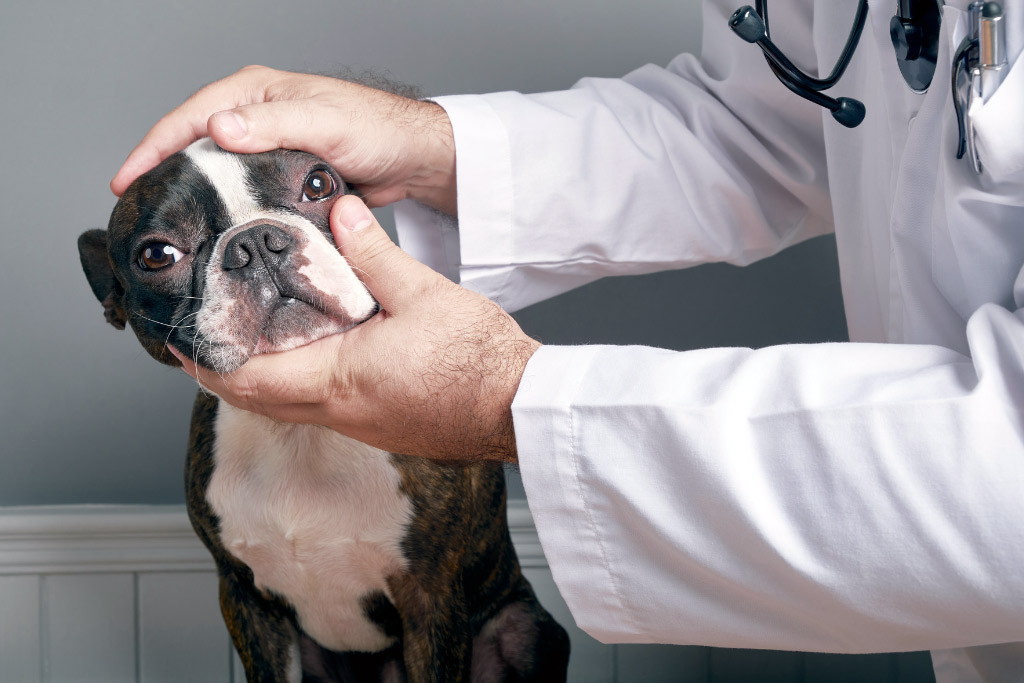
#3 – Cleaning Your Boston Terrier’s Eyes Weekly
Your Boston Terrier’s eyes need special care because of how prominent they are. Keeping your Boston Terrier’s eyes clean and dry is very important to prevent eye infections and other issues.
At least once a week, you should take the time to look at your dog’s eyes and clean any specks of dirt around them.
Rather than eye solutions, I prefer grooming wipes (these ones are free of alcohol, parabens and harsh chemicals).
I find that they are multi-purpose wipes, and in this case are useful to wipe the excess tears from the fur beneath the eye and prevent staining.
Read also: How to Clean Boston Terrier Eyes and Tear Stains
This routine will help you to keep an eye out for signs of eye infections mentioned above (Boston Terrier Eye Problems Signs). Always take your dog to the vet at the first sign of trouble.
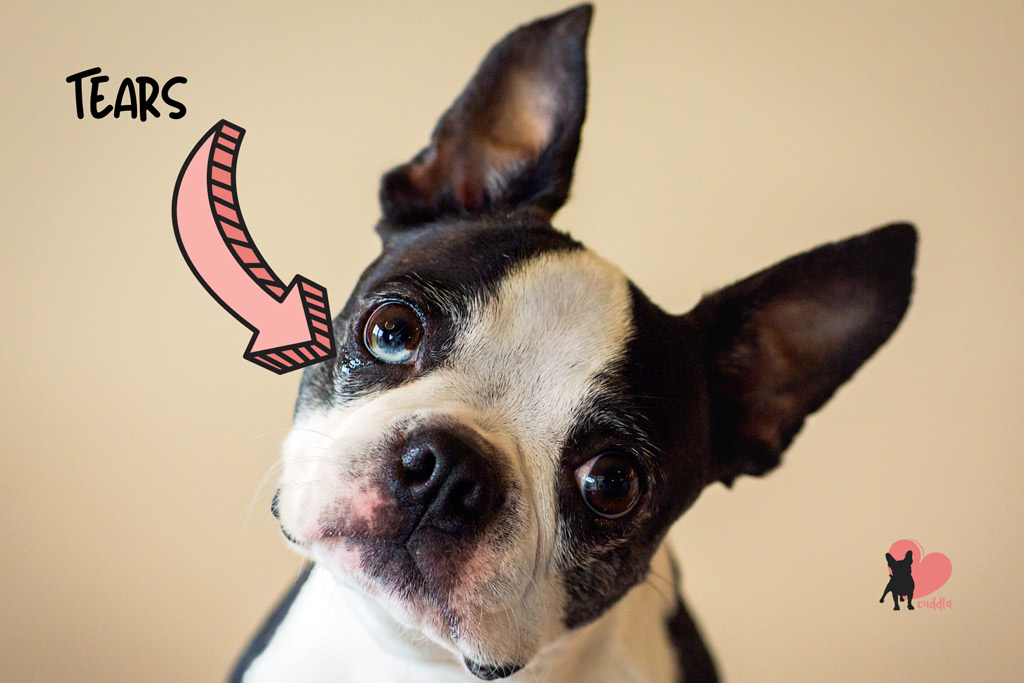
#4 – Following a Balanced Diet
Nutrition also plays a role in Boston Terriers’ health, including their eyes.
A species-appropriate balanced diet, according to their age, will make sure your Boston Terrier gets all the nutrients needed for a healthy and long life.
Boston Terriers should follow a balanced diet, which includes:
- High-quality protein: Lean-muscle meats, fish and eggs.
- Moderate level of animal fat: Salmon and sardines.
- High levels of EPA and DHA: Omega-3 from krill oil.
- A few fresh cut veggies: Broccoli and kale (mimics prey’s stomach contents).
- No grains (gluten-free).
- No potatoes or other starches.
- No artificial flavouring.
Plus, your furry friend should be well hydrated with fresh and filtered water (if necessary in your area).
Read also: What Do Boston Terriers Eat? Superfoods & Toxic Human Foods.

#5 – Keeping Boston Terriers’ Eyes Safe From Hazards
Because Boston Terriers’ eyes bulge out from their faces you need to be especially careful.
Basically, avoid having your Boston in close contact with anything that could potentially scratch the eyes.
Here’s what you can do:
- Around the house: Be mindful about how you arrange the furniture so that your dog doesn’t bump into it.
- When playing with toys: Make sure that none of your dog’s toys has sharp edges. Here’s a guide to safe dog toys.
- Around the garden: Avoid thorny plants such as roses or cactus, or make sure that area is not accessible to your Boston. Also, when going for walks, never allow your pooch to get close to thorny plants or bushes.
- During car trips: Don’t allow your dogs to stick their heads out. In any case, windows should be always closed, and if open, only enough for some fresh air to come through.
- Walking in dusty terrains: Dust and sand can become a hazard, especially when it’s windy. So avoid walking with your Boston in excessively dusty conditions or on windy days. It can be helpful to carry dog eyewash drops with you to wash out any particles that get into your dog’s eyes before your Boston rubs the eyes, risking scratches. Some dog owners even use dog goggles (for windy days and for swimming), which I had no clue that they existed!

#6 – Getting Your Boston From a Reputable Breeder or Rescue Group
As a dog owner, it’s important to understand how breeding practices can increase or decrease the chances of eye problems.
All hereditary diseases, including eye problems, can be avoided if you buy your Boston Terrier pup from a reputable breeder that:
- Screens for hereditary disease (genetic testing).
- Provides relevant health certificates for this particular breed*.
- Only breeds healthy dogs, avoiding other non-hereditary issues too.
If you’d rather adopt (which is a great option), rescue groups conduct health check-ups too and they would be able to tell you about your chosen Boston’s health. After adoption, you can test your pooch further to overrule hereditary diseases.
Consult with your vet to know what’s the best way to proceed.
Being informed about your dog’s health will facilitate better living conditions (no pain) and early treatments when necessary.
Read also: How to Find a Reputable Boston Terrier Breeder and What to Ask. * Includes the list of appropriate health certifications that a breeder should provide.

